Locked out of L.A.’s white neighborhoods, they built a black suburb. Now they’re homeless
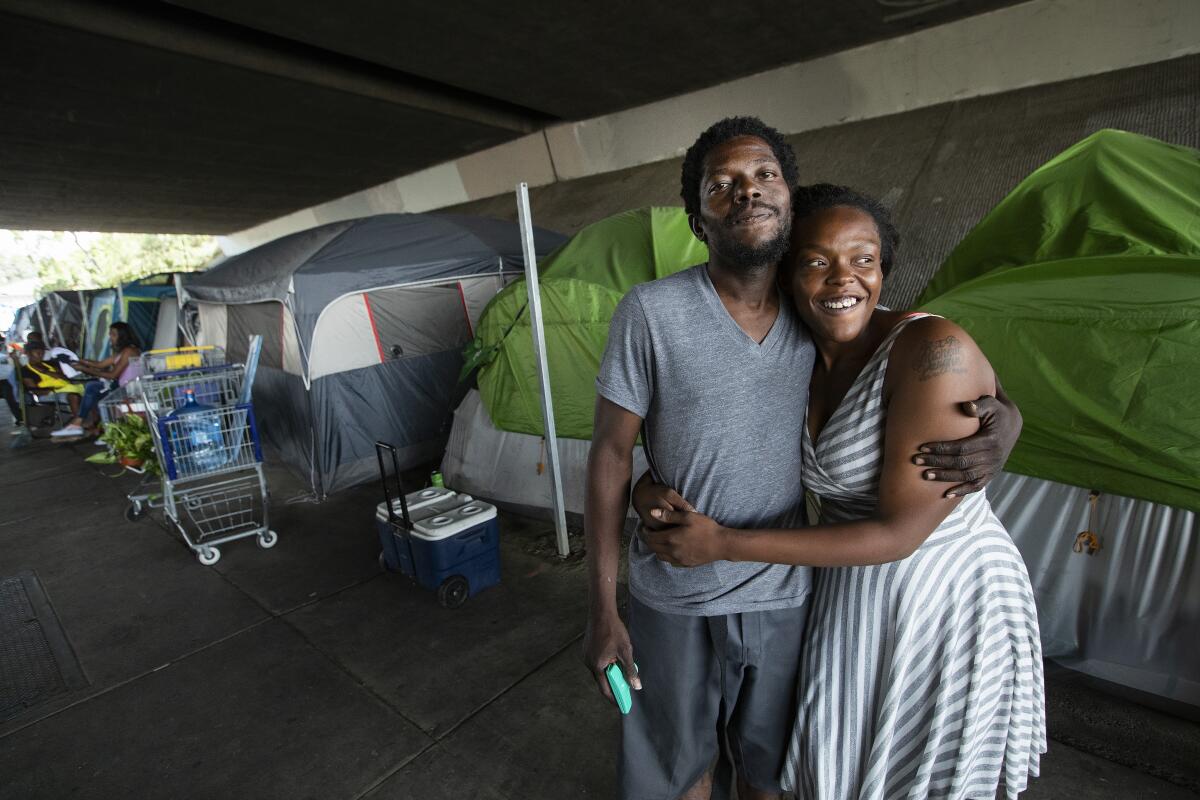
- Share via
Duane Pierfax grew up after World War II in Pacoima, one of the few Los Angeles suburbs that offered the American dream of home ownership to African Americans who had been locked out of other neighborhoods by racial covenants.
His stepfather worked at Lockheed Martin to support the family of 15. His sister worked at the General Motors plant in Van Nuys. She bought one of the Joe Louis Homes — no relation to the revered black boxing icon, but his name still drew African Americans fleeing lynchings and Jim Crow laws in the South to the rows of boxy houses.
But the 1990s brought deindustrialization, the crack cocaine epidemic and mass incarceration. With the advent of fair housing laws, some black people moved to other San Fernando Valley communities and beyond, but many African American families in Pacoima lost their homes as a result of those societal forces.
Now, Pierfax, 62, and four dozen other mostly African American people live a few miles away in a flotilla of tents under the Ronald Reagan Freeway. The giant encampment is a stark illustration of the racial disparity among homeless people that Los Angeles and cities across California are just starting to recognize and address.
In L.A. County, African Americans are 9% of the population, but 40% of its homeless population, and two-thirds of them live outside.
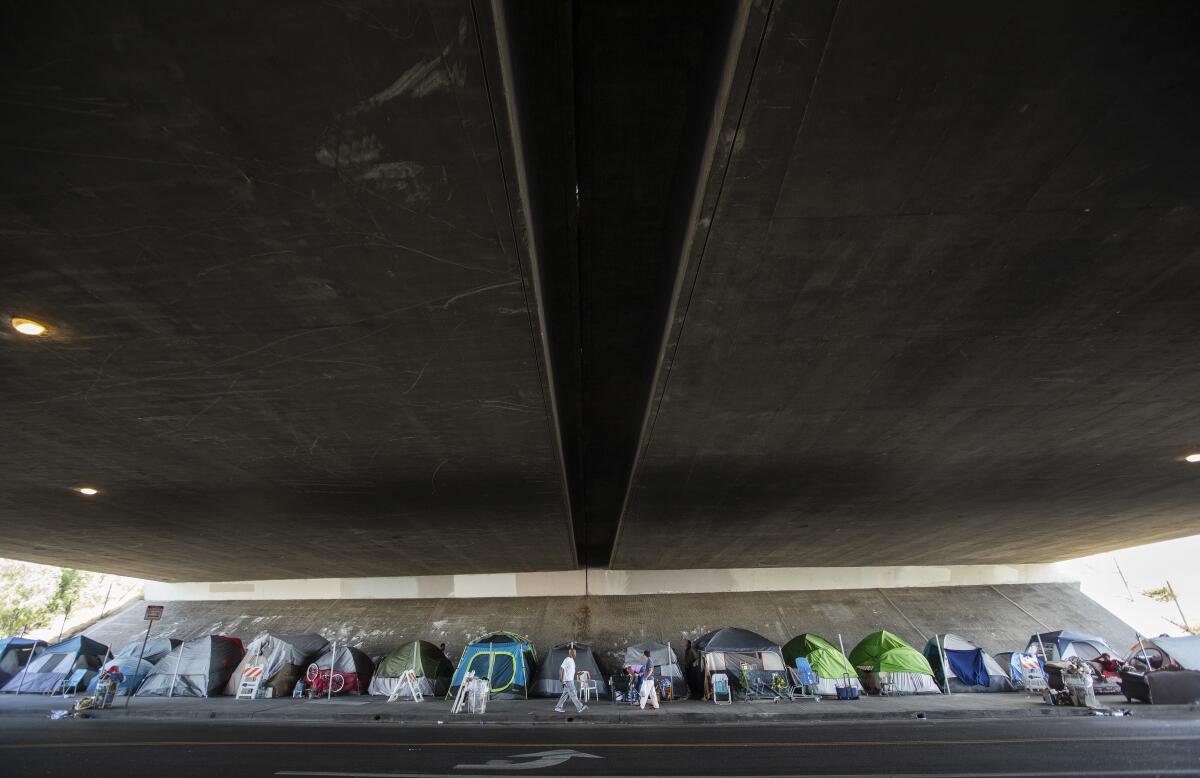
The poverty rate among black Angelenos does not fully account for the racial gap. That is not unique to L.A., but it’s particularly uncomfortable in a liberal city with a painful racial history, including the police beating of Rodney King and two riots.
In December, the Los Angeles Homeless Services Authority released a study blaming the disparity on generations of institutional and structural racism in housing and in the criminal justice, education and child welfare systems.
“The story of the debacle of the black middle class has been taken out of conversation and the onus is on the pathology of the individual,” said Suzette Shaw, a skid row activist and a member of an advisory committee for the report. “Workforce redlining, housing redlining have systemically displaced us.”
It would be hard to find a purer example of displacement than the Pacoima encampment. Some of its residents were laid off together by a Price Pfister faucet factory that no longer exists, said Kris Freed, chief program officer at LA Family Housing. Others grew up together. A few are blood relatives. Many have lived together in the streets for three to five years, Freed said.
“Those same individuals lived in these same homes that their parents bought in the 1950s and ‘60s,” said Crystal Jackson-Bradley, a Pacoima native and creator of a documentary and upcoming book about the community.

‘It’s madness’
The disparity study listed 67 recommendations to address the issue, among them: hiring formerly homeless African Americans for social services and affordable housing construction jobs; removing housing barriers for people with criminal records; and extending the foster care support system to people up to age 24.
But when Caltrans showed up in July and served camp residents with a notice to move out or face arrest, there was no obvious solution. Workers in hard hats pounded metal fenceposts into the dirt inches from the tents where people were still sleeping.
“We’ve been here three years and, all of a sudden, it’s madness,” said Beatrice Hart, 53, the camp’s unofficial den mother.
Attorneys from Neighborhood Legal Services intervened four days later, citing a recent court ruling that criminalizing sleeping in public streets while shelter space is inadequate is unconstitutional. That ruling is under attack on several fronts, and the U.S. Supreme Court is weighing an L.A. law firm’s request to hear the case.
But Caltrans agreed to put the ouster on hold until a “solution” can be found for the residents. Many are in line for housing, but the process is happening at a glacial pace.
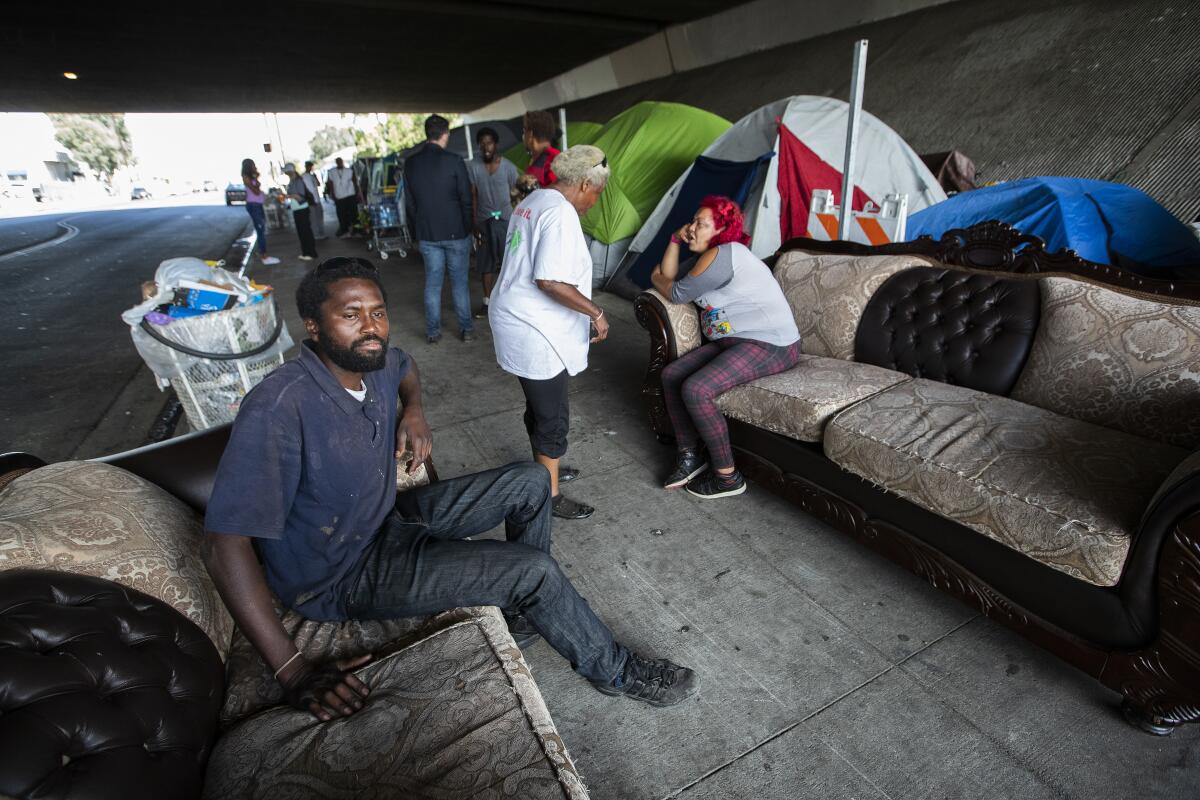
Freed said she is working with the homeless services authority and the legal aid agency on a plan to relocate many of the residents together, perhaps to four- or five-bedroom shared houses, “because they’re such a tight-knit group.”
Jacqueline Waggoner, a commissoner with the authority and the head of the committee that conducted the disparity study, suggested that the city find public land for a haven where the residents can wait until their housing comes through.
“If you fix this for black people, you fix it for everyone,” she said. “They’re the biggest group.”
A spokesman for Los Angeles Mayor Eric Garcetti said the city is not considering “sanctioned campgrounds” on public land.
“The mayor is focused right now on bringing everyone indoors, into the shelters and permanent housing we know are the keys to solving this crisis,” spokesman Alex Comisar said.
The encampment has been a hotspot for complaints to the city — 150 in 2018, according to city records.
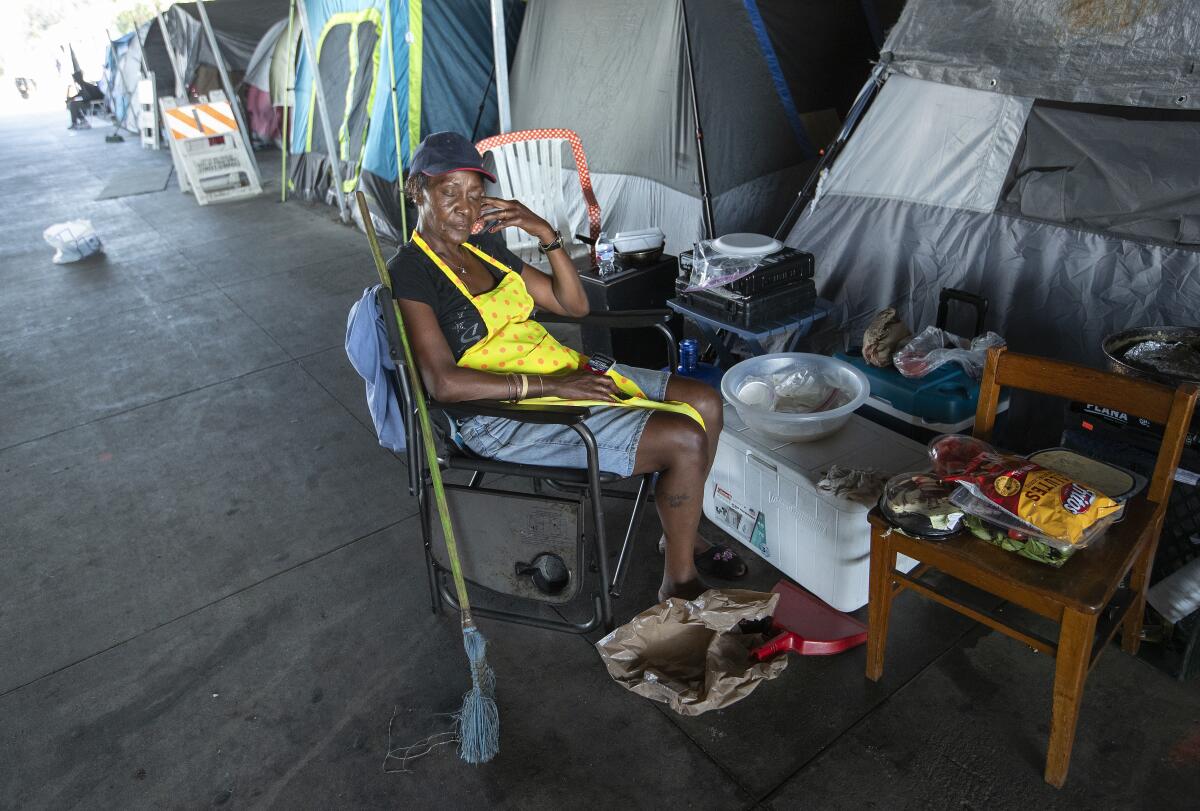
City Councilwoman Monica Rodriguez, whose district includes Pacoima, said City Atty. Mike Feuer’s office obtained orders for 10 people involved in sex trafficking and drugs to stay away. In March, Samuel Crenshaw, a 60-year-old black man, died after a stabbing among or near the tents.
The LAPD HOPE team of police and city sanitation workers has repeatedly moved the residents. It was the team who told the first members of the camp to leave a cul-de-sac in Pacoima, and they settled under the Ronald Reagan Freeway underpass about three years ago, residents said.
“The HOPE team was trying to find the least-populated area,” Rodriguez said.
Many in the encampment also said the team threw away their belongings, including an urn containing the ashes of resident Jessica Quinn’s son. The leader of the HOPE team did not return a call for comment.
Rodriguez said she has brought an array of homeless services to her district, including bridge housing, a winter shelter, a homeless services hub and the only safe parking lot in the city for people to sleep in their RVs.
“I can’t think of a box I haven’t checked,” she said.
‘We live here’
Pierfax has a keen awareness of the historical forces that washed him under the bridge. His mother’s family fled Mississippi for Pacoima, which was then largely dirt roads and open fields. Some of the first arrivals, ironically, lived in tents and Quonset huts.
His family helped form what became the center of African American life in the San Fernando Valley.
“It was thriving, especially for African Americans,” Pierfax said. “My sister bought a Camaro. Everybody bought GM products.”
His stepfather, a tool-and-die man, lost an eye in an industrial accident, but refused a settlement offer and followed Lockheed Martin to Lancaster. Pierfax said his sister took a buyout from General Motors, but the money only lasted so long and soon she had to find another job.
“Instead of finding yourself a home, now you have an apartment,” Pierfax said.
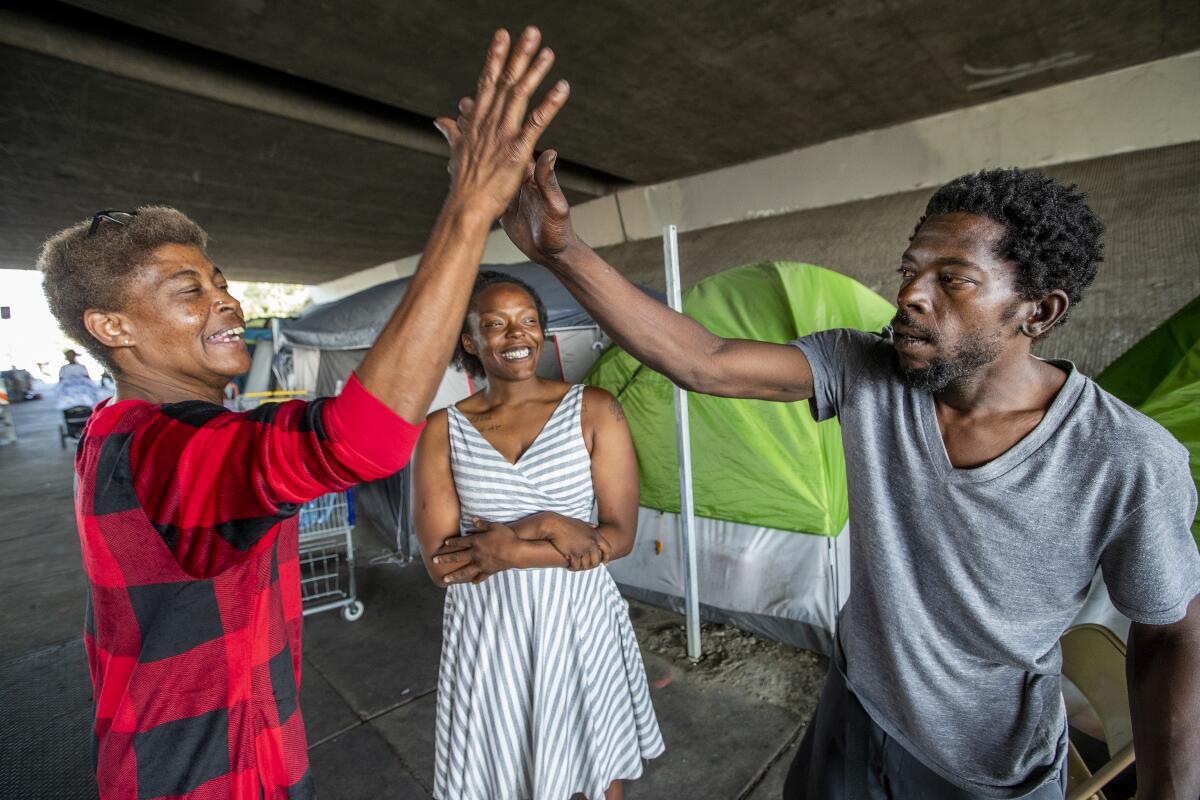
Pierfax attended Pacoima schools with mostly Latino and black students, but in the 1970s, was transferred to the west San Fernando Valley for high school as part of L.A.’s school busing debacle. He remembers climbing off the bus and seeing a racial slur splashed across the quad, where administrators must have noticed it.
“It was the worst first day of high school ever,” he said.
Pierfax played baseball in college and one of his sisters got a PhD. When things got tough, Pierfax said, he started selling illegal substances.
“I did what I had to do to survive,” he said. “I was the oldest of 13, I had to carry the load. I don’t like where I’m at, but I’m surprised I am not in a mental ward and that I’m still living.”
Pacoima’s African American population dropped from 75% in the 1970s to 10% 20 years later as Mexican immigrants, later joined by Salvadorans and Guatamalans, arrived. Joe Louis Homes and other tracts where black teachers, pastors and businesspeople once lived are now primarily occupied by middle-class Latinos.
The camp residents may stay in tents, but they are still very much part of the Pacoima community. Sisters, friends and pastors drop by regularly with food, water, dog food, eyeglasses and McDonald’s gift cards.
For a while, several pregnant women lived at the encampment. They moved out just before they gave birth. The residents collectively care for a litter of mop-topped puppies that scamper underfoot, and a dog that died there is buried in the freeway embankment under a grave marker.
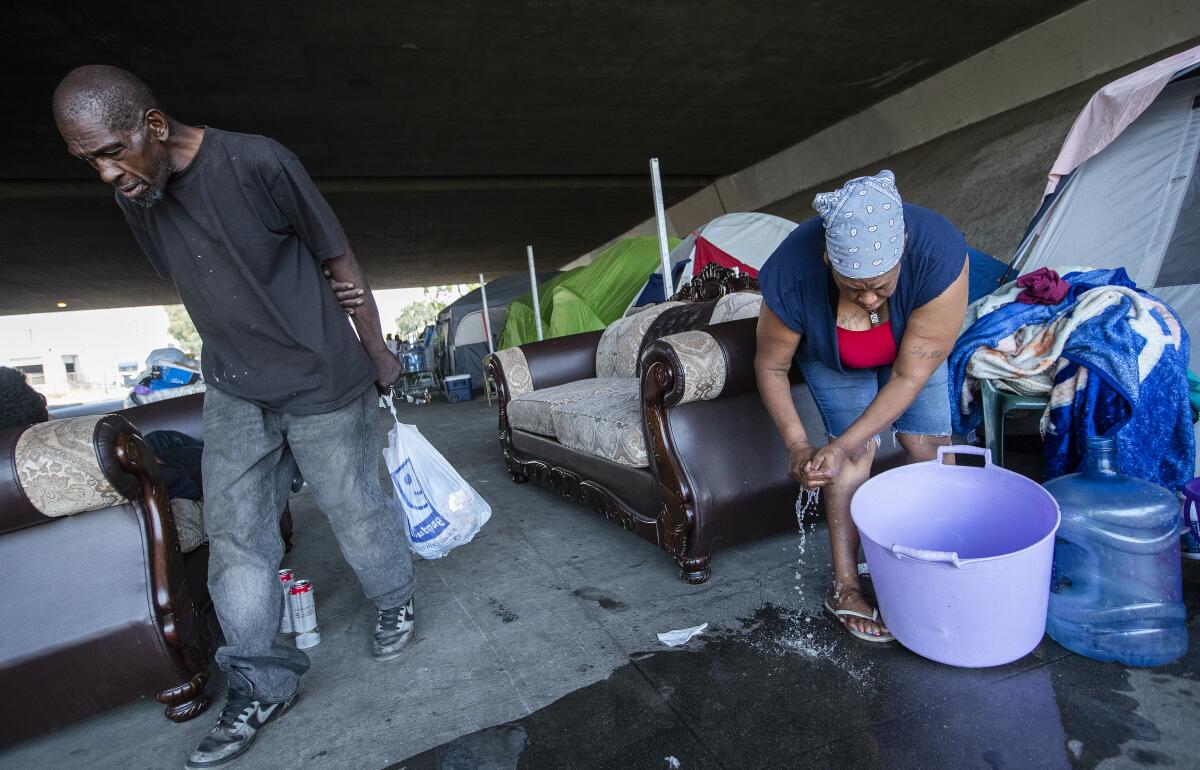
One woman, Sandra Wilson, has come to the encampment by bus, train and bus again from her home in the desert town of Mojave to gather residents for a prayer circle.
“Those were my friends and they’re still my friends,” said Wilson, 61.
Hart, the unofficial den mother, said a neighbor and her daughter brought a Christmas tree to the encampment over the holidays and decorated it.
With the help of homeless service workers, Hart recently moved into an apartment in Sunland, but most days she’s back at her friends’ tents under the freeway, helping to cook and maintain order. Caltrans’ metal fenceposts still mark the encampment’s boundaries.
“We all grew up together,” Hart said. “Our parents passed and the houses got sold. Where are we all going to go? We live here.”
More to Read
Sign up for Essential California
The most important California stories and recommendations in your inbox every morning.
You may occasionally receive promotional content from the Los Angeles Times.











